

Compact Muon Solenoid
LHC, CERN
| CMS-PAS-HIG-18-019 | ||
| Measurement of the associated production of a Higgs boson with a top quark pair in final states with electrons, muons and hadronically decaying $\tau$ leptons in data recorded in 2017 at $\sqrt{s} = $ 13 TeV | ||
| CMS Collaboration | ||
| November 2018 | ||
| Abstract: The production of a Higgs boson in association with a top quark pair ($\mathrm{t}\overline{\mathrm{t}}\mathrm{H}$) is measured in final states with electrons, muons and hadronically decaying $\tau$ leptons. Events are selected from a sample of proton-proton collisions at a $\sqrt{s} = $ 13 TeV center-of-mass energy, recorded by the CMS experiment in 2017 and corresponding to an integrated luminosity of 41.5 fb$^{-1}$. Machine learning and matrix element methods are used to optimize the analysis sensitivity. The observed (expected) $\mathrm{t}\overline{\mathrm{t}}\mathrm{H}$ production rate is 0.75$^{+0.46}_{-0.43}$ (1.00$^{+0.39}_{-0.35}$) times the expected rate in the standard model, which corresponds to an observed (expected) significance of 1.7$\sigma$ (2.9$\sigma$). In addition, these results are combined with those previously obtained from the data set collected in 2016 and corresponding to an integrated luminosity of 35.9 fb$^{-1}$. The observed (expected) signal rate for the combined fit is 0.96$^{+0.34}_{-0.31}$ (1.00$^{+0.30}_{-0.27}$) times the expected rate in the standard model, which corresponds to an observed (expected) significance of 3.2$\sigma$ (4.0$\sigma$). | ||
| Links: CDS record (PDF) ; inSPIRE record ; CADI line (restricted) ; | ||
| Figures | |
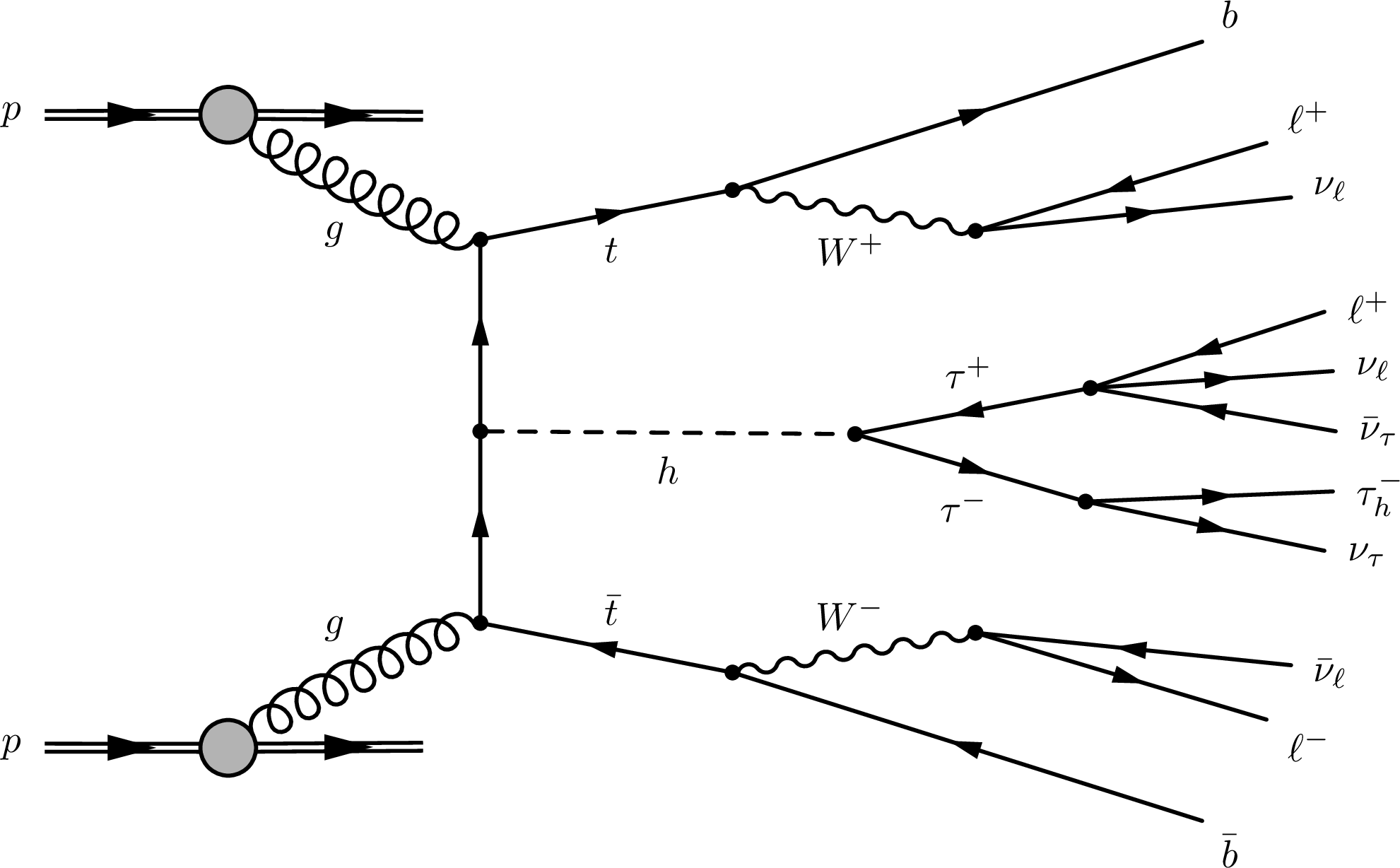
png pdf |
Figure 1:
An example Feynman diagram for $ {\mathrm {t}} {\overline {\mathrm {t}}} {{\mathrm {H}}}$ production, followed by $ {{\mathrm {H}}}$ boson decay into a $ {\tau}$ pair [6]. |
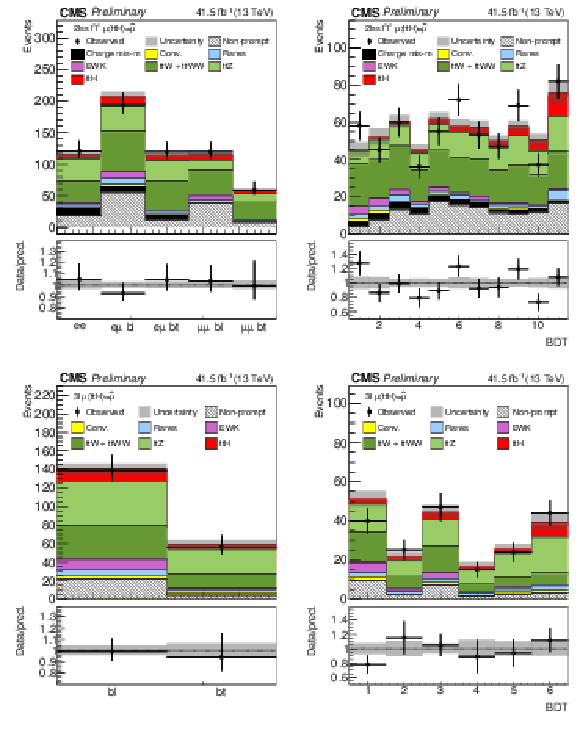
png pdf |
Figure 2:
Distributions in the discriminating observables used for the signal extraction in the $2 {\ell} {\text {ss}}$ and $3 {\ell}$ categories. Post-fit yields and uncertainties for the $ {{{\mathrm {t}}} {{\overline {\mathrm {t}}}} {{\mathrm {H}}}}$ signal and the background processes are shown. In (a) and (c) the distributions for the $2 {\ell} {\text {ss}}$ and $3 {\ell}$ sub-categories are shown; the x-axis labels "bl'' and "bt'' stand for "b-tag loose'' and "b-tag tight'', respectively. Further details are given in Section 7.2.1. |
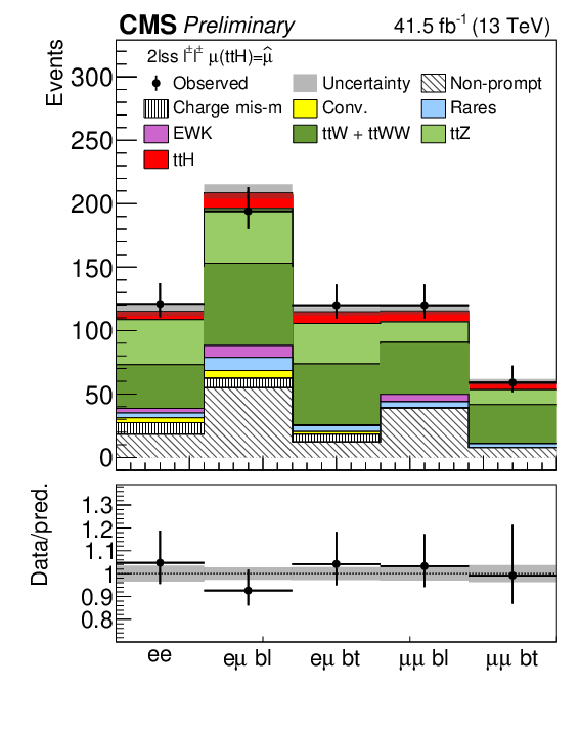
png pdf |
Figure 2-a:
The distributions for the $2 {\ell} {\text {ss}}$ sub-categories are shown. Further details are given in Section 7.2.1. |
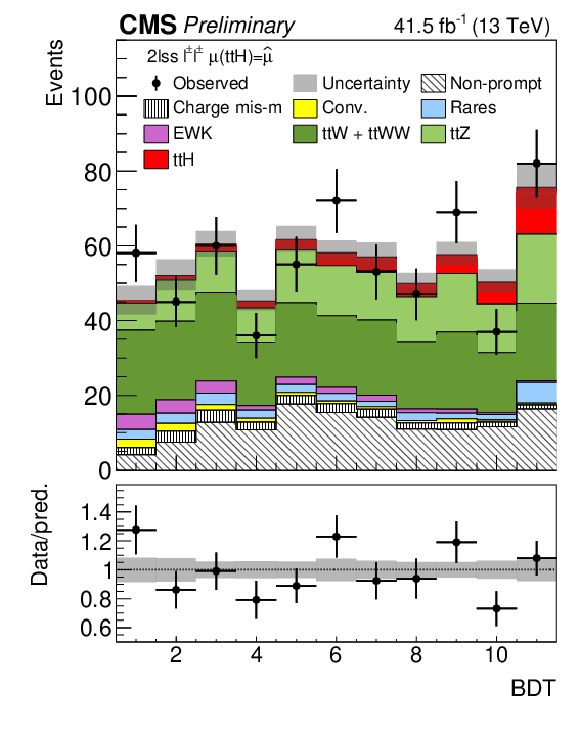
png pdf |
Figure 2-b:
Distribution in the discriminating observable used for the signal extraction in the $2 {\ell} {\text {ss}}$ categories. Post-fit yields and uncertainties for the $ {{{\mathrm {t}}} {{\overline {\mathrm {t}}}} {{\mathrm {H}}}}$ signal and the background processes are shown. Further details are given in Section 7.2.1. |

png pdf |
Figure 2-c:
The $3 {\ell}$ sub-categories are shown; the x-axis labels "bl'' and "bt'' stand for "b-tag loose'' and "b-tag tight'', respectively. Further details are given in Section 7.2.1. |
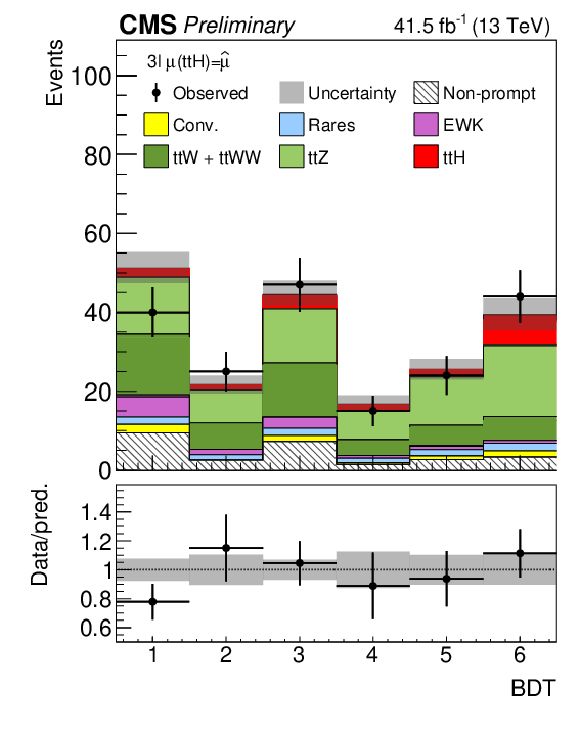
png pdf |
Figure 2-d:
Distribution in the discriminating observables used for the signal extraction in the $3 {\ell}$ categories. Post-fit yields and uncertainties for the $ {{{\mathrm {t}}} {{\overline {\mathrm {t}}}} {{\mathrm {H}}}}$ signal and the background processes are shown. Further details are given in Section 7.2.1. |
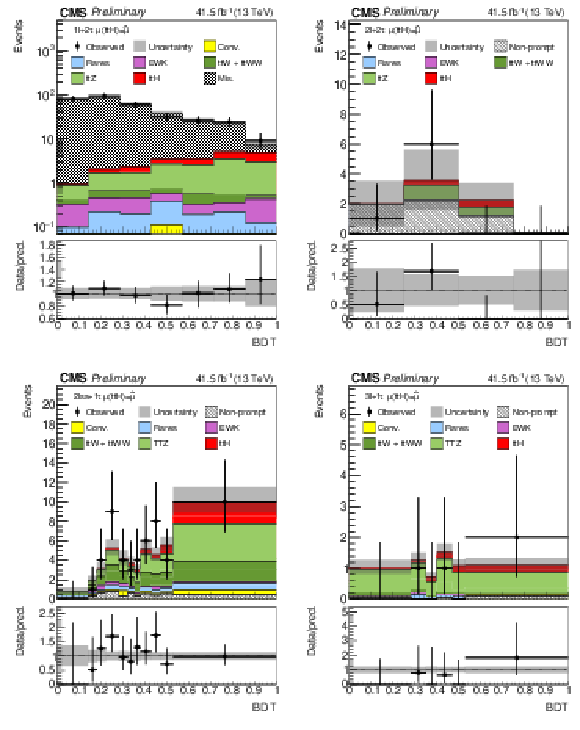
png pdf |
Figure 3:
Distributions in the discriminating observables used for the signal extraction in (a) the $1 {\ell}+2 {{\tau}_{\mathrm {h}}} $, (b) the $2 {\ell}+2 {{\tau}_{\mathrm {h}}} $, (c) the $2 {\ell}ss+1 {{\tau}_{\mathrm {h}}} $, and (d) $3 {\ell}+1 {{\tau}_{\mathrm {h}}} $ categories. Post-fit yields and uncertainties for the $ {{{\mathrm {t}}} {{\overline {\mathrm {t}}}} {{\mathrm {H}}}}$ signal and the background processes are shown. |

png pdf |
Figure 3-a:
Distributions in the discriminating observables used for the signal extraction in the $1 {\ell}+2 {{\tau}_{\mathrm {h}}} $ category. Post-fit yields and uncertainties for the $ {{{\mathrm {t}}} {{\overline {\mathrm {t}}}} {{\mathrm {H}}}}$ signal and the background processes are shown. |
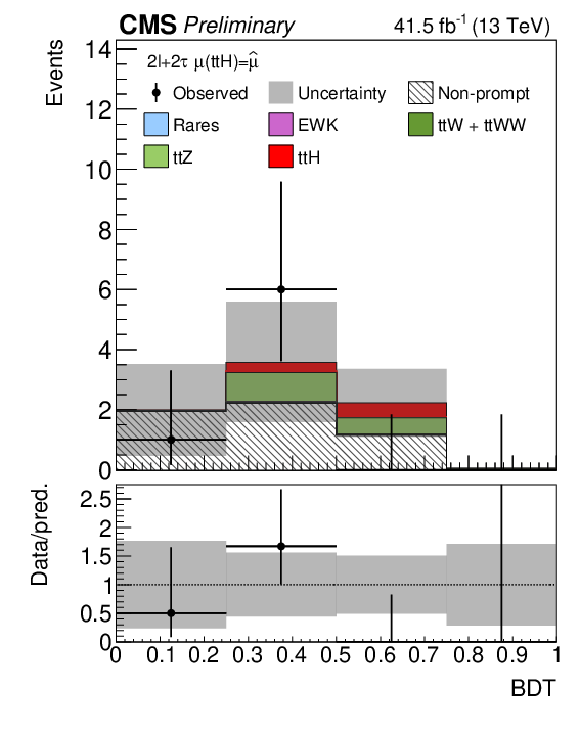
png pdf |
Figure 3-b:
Distributions in the discriminating observables used for the signal extraction in the $2 {\ell}+2 {{\tau}_{\mathrm {h}}} $ category. Post-fit yields and uncertainties for the $ {{{\mathrm {t}}} {{\overline {\mathrm {t}}}} {{\mathrm {H}}}}$ signal and the background processes are shown. |
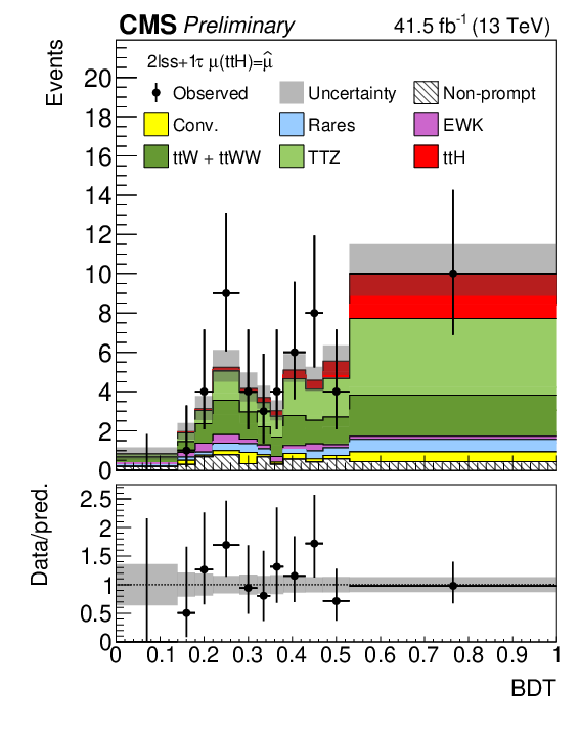
png pdf |
Figure 3-c:
Distributions in the discriminating observables used for the signal extraction in the $2 {\ell}ss+1 {{\tau}_{\mathrm {h}}} $ category. Post-fit yields and uncertainties for the $ {{{\mathrm {t}}} {{\overline {\mathrm {t}}}} {{\mathrm {H}}}}$ signal and the background processes are shown. |
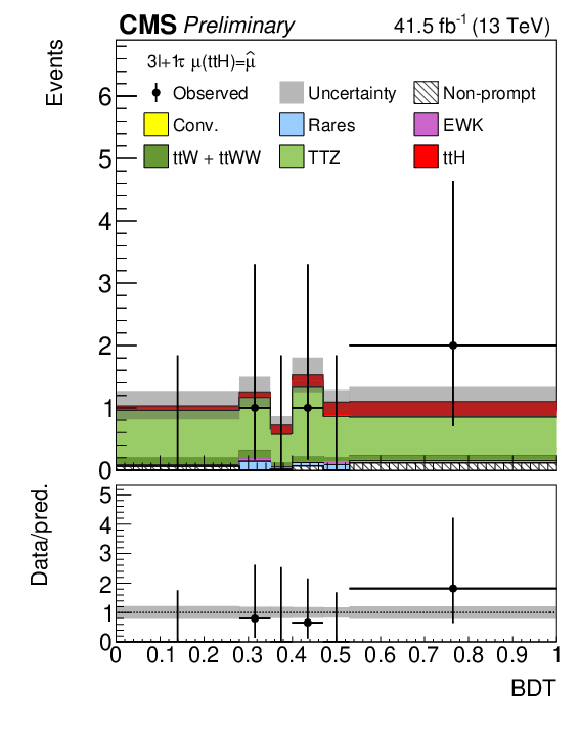
png pdf |
Figure 3-d:
Distributions in the discriminating observables used for the signal extraction in the $3 {\ell}+1 {{\tau}_{\mathrm {h}}} $ category. Post-fit yields and uncertainties for the $ {{{\mathrm {t}}} {{\overline {\mathrm {t}}}} {{\mathrm {H}}}}$ signal and the background processes are shown. |
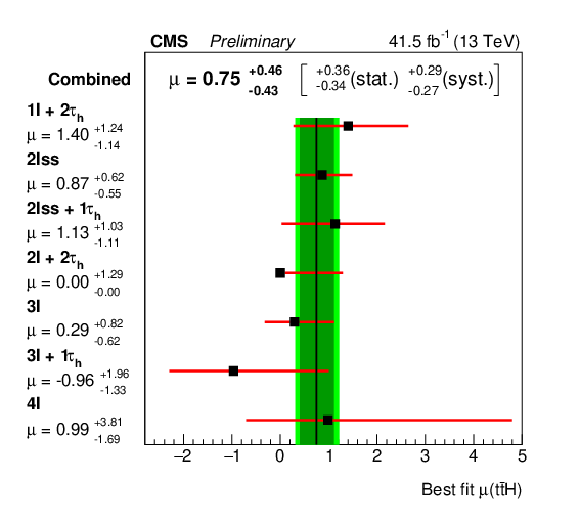
png pdf |
Figure 4:
Measured signal rates, normalized to the SM $ {\mathrm {t}} {\overline {\mathrm {t}}} {{\mathrm {H}}}$ production rate, for the individual categories and for the combination of all seven categories. |

png pdf |
Figure 5:
95% CL upper limits on the signal-rate multiplier, $\mu $, obtained for the individual categories and for the combination of all seven categories. |
| Tables | |

png pdf |
Table 1:
List of event generators used to produce samples for signal and background processes. |
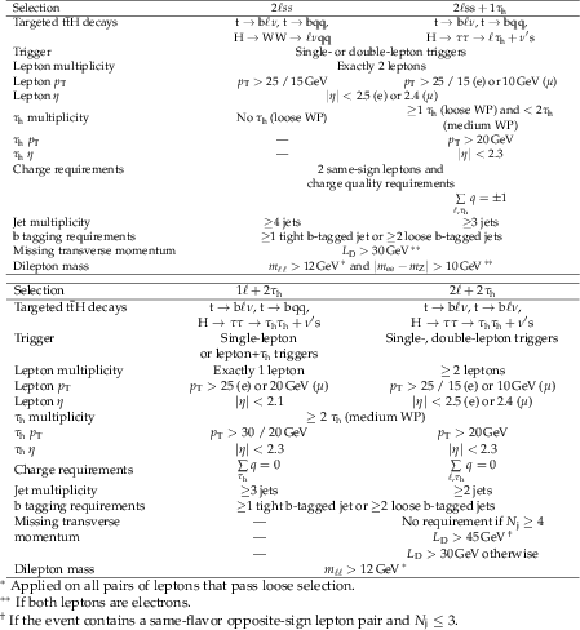
png pdf |
Table 2:
Event selections applied in the $2 {\ell} {\text {ss}}$, $2 {\ell} {\text {ss}}+ 1 {{\tau}_{\mathrm {h}}} $, $1 {\ell}+ 2 {{\tau}_{\mathrm {h}}} $ and $2 {\ell}+ 2 {{\tau}_{\mathrm {h}}} $ categories. |
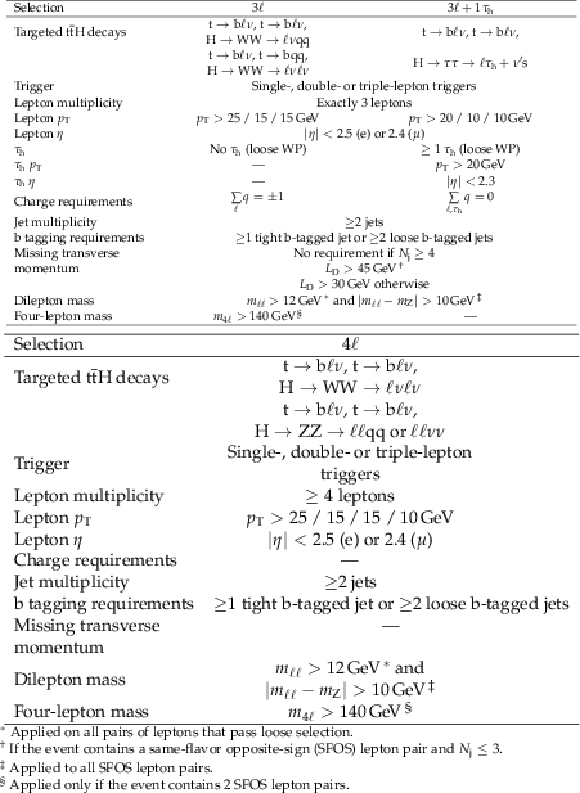
png pdf |
Table 3:
Event selections applied in the $3 {\ell}$, $3 {\ell}+1 {{\tau}_{\mathrm {h}}} $ and $4 {\ell}$ categories. |

png pdf |
Table 4:
Variables used in the multivariate discriminators for the channels with and without taus. Only one multivariate discriminant is used in categories with ${{\tau}_{\mathrm {h}}}$. For the categories without ${{\tau}_{\mathrm {h}}}$, two different multivariate discriminants are constructed, each one providing better discrimination against a specific background process. The $cos(\theta)^*$ between leading and trailing ${{{\tau}_{\mathrm {h}}}}$s is measured in the rest frame of the ${{\tau}_{\mathrm {h}}}$ pair. Masses of ${{\ell}}$s $+$ leading ${{\tau}_{\mathrm {h}}}$, in the $3 {\ell}+ 1 {{\tau}_{\mathrm {h}}} $ category, are constructed based on the leptons that have opposite signs to ${{\tau}_{\mathrm {h}}}$. |

png pdf |
Table 5:
Summary of the main sources of systematic uncertainty and their impact on the measured signal rate. The $\Delta \mu $/$\mu $ column shows the approximate relative shift in signal rate when varying the systematic uncertainty source by its value. Impacts are shown both for the 2017 analysis and for the 2016 + 2017 combined analysis. A general indication on the treatment of their correlations between the 2016 and 2017 samples in the combined analysis is also given. |

png pdf |
Table 6:
The selected number of events in categories based on leptons and hadronic $\tau $s ($ {{\tau}_{\mathrm {h}}} $). The numbers in row "SM expectation'' also include $ {{{\mathrm {t}}} {{\overline {\mathrm {t}}}} {{\mathrm {H}}}}$ process. The rates are adjusted using the maximum-likelihood fit (post-fit). |

png pdf |
Table 7:
The measured and expected signal rates are presented as signal-rate multipliers, $\mu $, which are normalized to the SM $ {\mathrm {t}} {\overline {\mathrm {t}}} {{\mathrm {H}}}$ production rate, for the individual categories and for the combination of all seven categories. In addition, a combination with the results obtained from the 2016 dataset [6] is made and added to the table. The * indicates that a lower boundary was introduced in the allowed $\mu $ range to improve the fit convergence properties in the low-yield $2 {\ell}+ 2 {{\tau}_{\mathrm {h}}} $ category. |
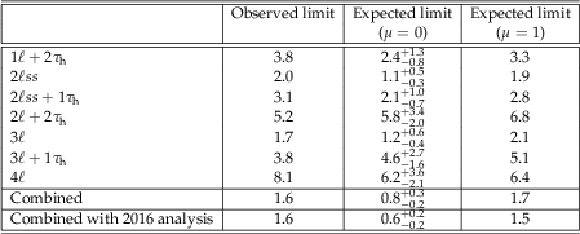
png pdf |
Table 8:
95% CL upper limits on the signal-rate multiplier, $\mu $, obtained for the individual categories and for the combination of all seven categories. In addition, a combination with the results obtained from the 2016 dataset [6] is made and added to the table. The observed limit is compared to the expected limits for the background-only hypothesis ($\mu = $ 0) and for the hypothesis where the SM $ {{{\mathrm {t}}} {{\overline {\mathrm {t}}}} {{\mathrm {H}}}}$ process is expected ($\mu = $ 1). |
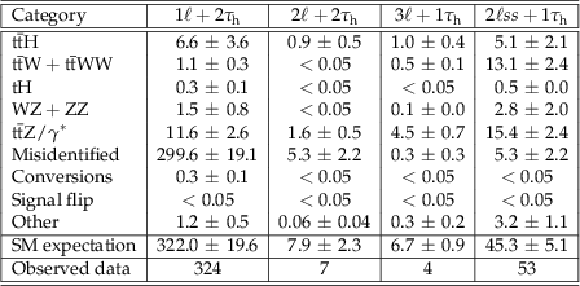
png pdf |
Table 9:
Selected number of events in the $1 {\ell}+ 2 {{\tau}_{\mathrm {h}}} $, $2 {\ell}ss + 1 {{\tau}_{\mathrm {h}}} $, $2 {\ell}+ 2 {{\tau}_{\mathrm {h}}} $, and $3 {\ell}+ 1 {{\tau}_{\mathrm {h}}} $ categories. The "SM expectation'' row also includes the $ {{{\mathrm {t}}} {{\overline {\mathrm {t}}}} {{\mathrm {H}}}}$ process. The rates are adjusted using the maximum-likelihood fit (post-fit). |

png pdf |
Table 10:
Selected number of events in the $2 {\ell}ss$ subcategories. The "SM expectation'' row also includes the $ {{{\mathrm {t}}} {{\overline {\mathrm {t}}}} {{\mathrm {H}}}}$ process. The rates are adjusted using the maximum-likelihood fit (post-fit). |

png pdf |
Table 11:
Selected number of events in the $2 {\ell}ss$ control regions. The "SM expectation'' row also includes the $ {{{\mathrm {t}}} {{\overline {\mathrm {t}}}} {{\mathrm {H}}}}$ process. The rates are adjusted using the maximum-likelihood fit (post-fit). |
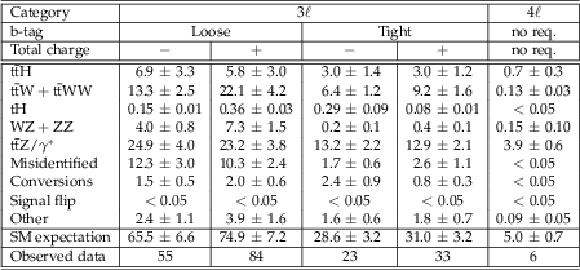
png pdf |
Table 12:
Selected number of events in the $3 {\ell}$ and $4 {\ell}$ categories. The "SM expectation'' row also includes the $ {{{\mathrm {t}}} {{\overline {\mathrm {t}}}} {{\mathrm {H}}}}$ process. The rates are adjusted using the maximum-likelihood fit (post-fit). |
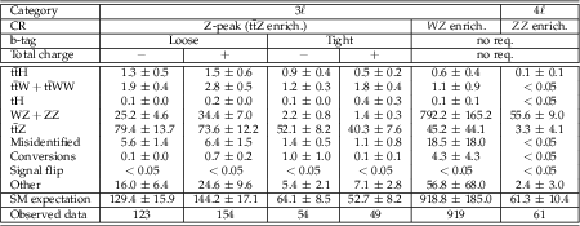
png pdf |
Table 13:
Selected number of events in the $3 {\ell}$ and $4 {\ell}$ control regions. The "SM expectation'' row also includes the $ {{{\mathrm {t}}} {{\overline {\mathrm {t}}}} {{\mathrm {H}}}}$ process. The rates are adjusted using the maximum-likelihood fit (post-fit). |
| Summary |
| A measurement of the production of a Higgs boson in association with a top quark pair in final states with electrons, muons and hadronically decaying $\tau$ leptons has been presented. Events from the sample of proton-proton collisions recorded by the CMS experiment in 2017 are categorized according to the number of leptons and ${\tau_\mathrm{h}}$. Machine learning and matrix element methods are used to optimize the analysis sensitivity. A $\mathrm{t}\overline{\mathrm{t}}\mathrm{H}$ production rate of 0.75$^{+0.46}_{-0.43}$ (1.00$^{+0.39}_{-0.35}$) times the SM expectation is observed (expected), corresponding to a significance of 1.7$\sigma$ ($2.9\sigma$). These results are combined with those obtained from the data set collected in 2016 and reported in Ref. [6]. The combined fit yields an observed (expected) signal rate of 0.96$^{+0.34}_{-0.31}$ (1.00$^{+0.30}_{-0.27}$) times the SM expectation, which corresponds to a significance of 3.2$\sigma$ (4.0$\sigma$). All results are consistent with the SM expectation. |
| References | ||||
| 1 | CMS Collaboration | Observation of a new boson at a mass of 125 GeV with the CMS experiment at the LHC | PLB 716 (2012) 30 | CMS-HIG-12-028 1207.7235 |
| 2 | ATLAS Collaboration | Observation of a new particle in the search for the standard model Higgs boson with the ATLAS detector at the LHC | PLB 716 (2012) 1 | 1207.7214 |
| 3 | ATLAS and CMS Collaborations | Combined measurement of the Higgs boson mass in $ {\mathrm{p}}{\mathrm{p}} $ collisions at $ \sqrt{s}= $ 7 and 8~ TeV with the ATLAS and CMS experiments | PRL 114 (2015) 191803 | 1503.07589 |
| 4 | ATLAS Collaboration | Observation of Higgs boson production in association with a top quark pair at the LHC with the ATLAS detector | PLB784 (2018) 173--191 | 1806.00425 |
| 5 | CMS Collaboration | Observation of $ \mathrm{t\overline{t}} $H production | PRL 120 (2018) 231801 | CMS-HIG-17-035 1804.02610 |
| 6 | CMS Collaboration | Evidence for associated production of a Higgs boson with a top quark pair in final states with electrons, muons, and hadronically decaying $ \tau $ leptons at $ \sqrt{s} = $ 13 TeV | JHEP 08 (2018) 066 | CMS-HIG-17-018 1803.05485 |
| 7 | A. Hoecker et al. | TMVA --- toolkit for multivariate data analysis | PoS ACAT (2007) 040 | physics/0703039 |
| 8 | F. Pedregosa et al. | Scikit-learn: Machine learning in Python | JMLR 12 (2011) 2825 | 1201.0490 |
| 9 | K. Kondo | Dynamical likelihood method for reconstruction of events with missing momentum. 1: method and toy models | J. Phys. Soc. Jap. 57 (1988) 4126 | |
| 10 | K. Kondo | Dynamical likelihood method for reconstruction of events with missing momentum. 2: mass spectra for $ 2 \to 2 $ processes | J. Phys. Soc. Jap. 60 (1991) 836 | |
| 11 | CMS Collaboration | Description and performance of track and primary-vertex reconstruction with the CMS tracker | JINST 9 (2014) P10009 | CMS-TRK-11-001 1405.6569 |
| 12 | CMS Collaboration | The CMS trigger system | JINST 12 (2017) P01020 | CMS-TRG-12-001 1609.02366 |
| 13 | CMS Collaboration | The CMS experiment at the CERN LHC | JINST 3 (2008) S08004 | CMS-00-001 |
| 14 | J. Alwall et al. | The automated computation of tree-level and next-to-leading order differential cross sections, and their matching to parton shower simulations | JHEP 07 (2014) 079 | 1405.0301 |
| 15 | R. Frederix and S. Frixione | Merging meets matching in MC@NLO | JHEP 12 (2012) 061 | 1209.6215 |
| 16 | J. Alwall et al. | Comparative study of various algorithms for the merging of parton showers and matrix elements in hadronic collisions | EPJC53 (2008) 473--500 | 0706.2569 |
| 17 | P. Nason | A new method for combining NLO QCD with shower Monte Carlo algorithms | JHEP 11 (2004) 040 | hep-ph/0409146 |
| 18 | S. Frixione, P. Nason, and C. Oleari | Matching NLO QCD computations with parton shower simulations: the POWHEG method | JHEP 11 (2007) 070 | 0709.2092 |
| 19 | S. Alioli, P. Nason, C. Oleari, and E. Re | A general framework for implementing NLO calculations in shower Monte Carlo programs: the POWHEG BOX | JHEP 06 (2010) 043 | 1002.2581 |
| 20 | R. Frederix, E. Re, and P. Torrielli | Single-top t-channel hadroproduction in the four-flavour scheme with POWHEG and aMC@NLO | JHEP 09 (2012) 130 | 1207.5391 |
| 21 | E. Re | Single-top Wt-channel production matched with parton showers using the POWHEG method | EPJC71 (2011) 1547 | 1009.2450 |
| 22 | T. Melia, P. Nason, R. Rontsch, and G. Zanderighi | W+W-, WZ and ZZ production in the POWHEG BOX | JHEP 11 (2011) 078 | 1107.5051 |
| 23 | S. Frixione, P. Nason, and G. Ridolfi | A Positive-weight next-to-leading-order Monte Carlo for heavy flavour hadroproduction | JHEP 09 (2007) 126 | 0707.3088 |
| 24 | T. Sjostrand, S. Mrenna, and P. Z. Skands | A brief introduction to PYTHIA 8.1 | CPC 178 (2008) 852 | 0710.3820 |
| 25 | LHC Higgs Cross Section Working Group Collaboration | Handbook of LHC Higgs Cross Sections: 4. Deciphering the Nature of the Higgs Sector | 1610.07922 | |
| 26 | P. Kant et al. | HATHOR for single top-quark production: Updated predictions and uncertainty estimates for single top-quark production in hadronic collisions | CPC 191 (2015) 74 | 1406.4403 |
| 27 | M. Aliev et al. | HATHOR: HAdronic Top and Heavy quarks crOss section calculatoR | CPC 182 (2011) 1034 | 1007.1327 |
| 28 | N. Kidonakis | Two-loop soft anomalous dimensions for single top quark associated production with a $ \mathrm{W}^{-} $ or $ \mathrm{H}^{-} $ | PRD 82 (2010) 054018 | 1005.4451 |
| 29 | J. M. Campbell, R. K. Ellis, and C. Williams | Vector boson pair production at the LHC | JHEP 07 (2011) 018 | 1105.0020 |
| 30 | K. Melnikov and F. Petriello | Electroweak gauge boson production at hadron colliders through O($ \alpha_{s}^{2} $) | PRD 74 (2006) 114017 | hep-ph/0609070 |
| 31 | M. Czakon and A. Mitov | Top++: A program for the calculation of the top-pair cross section at hadron colliders | CPC 185 (2014) 2930 | 1112.5675 |
| 32 | \GEANTfour Collaboration | GEANT4--a simulation toolkit | NIMA 506 (2003) 250 | |
| 33 | CMS Collaboration | Particle-flow reconstruction and global event description with the CMS detector | JINST 12 (2017) P10003 | CMS-PRF-14-001 1706.04965 |
| 34 | E. Chabanat and N. Estre | Deterministic annealing for vertex finding at CMS | in Computing in high energy physics and nuclear physics. Proceedings, Conference, CHEP'04, Interlaken, Switzerland, September 27-October 1, 2004, pp. 287--290 CERN, Geneva | |
| 35 | W. Waltenberger, R. Fruhwirth, and P. Vanlaer | Adaptive vertex fitting | JPG 34 (2007) N343 | |
| 36 | M. Cacciari, G. P. Salam, and G. Soyez | The anti-$ {k_{\mathrm{T}}} $ jet clustering algorithm | JHEP 04 (2008) 063 | 0802.1189 |
| 37 | M. Cacciari, G. P. Salam, and G. Soyez | $ FastJet $ user manual | EPJC 72 (2012) 1896 | 1111.6097 |
| 38 | CMS Collaboration | Performance of electron reconstruction and selection with the CMS detector in $ {\mathrm{p}}{\mathrm{p}} $ collisions at $ \sqrt{s} = $ 8 TeV | JINST 10 (2015) P06005 | CMS-EGM-13-001 1502.02701 |
| 39 | CMS Collaboration | Performance of CMS muon reconstruction in $ {\mathrm{p}}{\mathrm{p}} $ collision events at $ \sqrt{s} = $ 7 TeV | JINST 7 (2012) P10002 | CMS-MUO-10-004 1206.4071 |
| 40 | CMS Collaboration | Reconstruction and identification of $ \tau $ lepton decays to hadrons and $ {\mathrm{n}}ut $ at CMS | JINST 11 (2016) P01019 | CMS-TAU-14-001 1510.07488 |
| 41 | CMS Collaboration | Performance of reconstruction and identification of $ \tau $ leptons in their decays to hadrons and $ {\mathrm{n}}ut $ in LHC Run 2 | CMS-PAS-TAU-16-002 | CMS-PAS-TAU-16-002 |
| 42 | M. Cacciari, G. P. Salam, and G. Soyez | The catchment area of jets | JHEP 04 (2008) 005 | 0802.1188 |
| 43 | M. Cacciari and G. P. Salam | Pileup subtraction using jet areas | PLB 659 (2008) 119 | 0707.1378 |
| 44 | CMS Collaboration | Jet algorithms performance in 13 TeV data | CMS-PAS-JME-16-003 | CMS-PAS-JME-16-003 |
| 45 | CMS Collaboration | Determination of jet energy calibration and transverse momentum resolution in CMS | JINST 6 (2011) P11002 | CMS-JME-10-011 1107.4277 |
| 46 | CMS Collaboration | Identification of b quark jets with the CMS experiment | JINST 8 (2013) P04013 | CMS-BTV-12-001 1211.4462 |
| 47 | CMS Collaboration | Identification of b quark jets at the CMS experiment in the LHC Run 2 | CMS-PAS-BTV-15-001 | CMS-PAS-BTV-15-001 |
| 48 | CMS Collaboration | Identification of heavy-flavour jets with the cms detector in pp collisions at 13 tev | Journal of Instrumentation 13 (2018), no. 05, P05011 | CMS-BTV-16-002 1712.07158 |
| 49 | CMS Collaboration | Performance of the CMS missing transverse momentum reconstruction in $ {\mathrm{p}}{\mathrm{p}} $ data at $ \sqrt{s} = $ 8 TeV | JINST 10 (2015) P02006 | CMS-JME-13-003 1411.0511 |
| 50 | CMS Collaboration | Performance of missing energy reconstruction in 13 TeV pp collision data using the CMS detector | CMS-PAS-JME-16-004 | CMS-PAS-JME-16-004 |
| 51 | Particle Data Group | Review of particle physics | CPC 38 (2014) 090001 | |
| 52 | CMS Collaboration | Measurements of properties of the Higgs boson decaying into the four-lepton final state in pp collisions at $ \sqrt{s}= $ 13 TeV | JHEP 11 (2017) 047 | CMS-HIG-16-041 1706.09936 |
| 53 | M. Cacciari et al. | The $ \mathrm{ t \bar{t} } $ cross-section at $ 1.8 $~ TeV and $ 1.96 $~$ TeV: $ a study of the systematics due to parton densities and scale dependence | JHEP 04 (2004) 068 | hep-ph/0303085 |
| 54 | S. Catani, D. de Florian, M. Grazzini, and P. Nason | Soft gluon resummation for Higgs boson production at hadron colliders | JHEP 07 (2003) 028 | hep-ph/0306211 |
| 55 | R. Frederix et al. | Four-lepton production at hadron colliders: aMC@NLO predictions with theoretical uncertainties | JHEP 02 (2012) 099 | 1110.4738 |
| 56 | CMS Collaboration | Jet energy scale and resolution at $ \sqrt{s} = $ 13 TeV | ||
| 57 | CMS Collaboration | Measurement of the cross section for top quark pair production in association with a W or Z boson in proton-proton collisions at $ \sqrt{s} = $ 13 TeV | JHEP 08 (2018) 011 | CMS-TOP-17-005 1711.02547 |

|
Compact Muon Solenoid LHC, CERN |

|

|

|

|

|

|